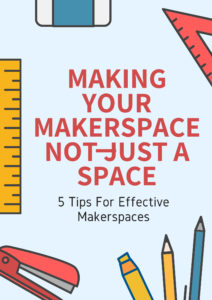(This page contains affiliate links)
A Makerspace is any place in which learners can share STEAM (Sciences, Technology, Engineerings, Arts and Mathematics) related concepts of interest, and then collaborate with other learners on ideas and hands-on constructed projects.
Lamens terms…. a Makerspace is a place for kids to bring their imagination to life! It can be a corner of the classroom loaded with all sorts of recycled or new items that students can use to create whatever invention or project interests them.
 5 ways to get the most out of a Makerspace:
5 ways to get the most out of a Makerspace:
1. Use items that can be replenished easily
Utilize recycled items such as newspaper, plastic bottles, milk jugs etc. to get you started. Ask students to bring in these items from home. You can also buy tons of crafts supplies at the dollar store for cheap. Including these items in your makerspace helps kids realize that previously used and everyday products can be refurbished into new things. Some categories to get you thinking about supplies are:
papers (white paper, colored paper, cardstock, newspaper etc)
plastics (plates, cups, bowls, spoons, baggies, straws)
craft supplies (pompoms, pipecleaners, beads, yarn, felt, fabric)
hardware (rulers, sandpaper, bolts, screws, magnets, washers, wire)
adhesive (masking tape, glue, hot glue, wood glue, duct tape, rubber bands)
toiletries (cotton balls, q-tips, dental floss, toilet paper tubes)
2. Space needs a clear introduction
Students won’t naturally know how to use the space. They need an introduction in the engineering process. For instance, they need to learn the importance of drawing a design before they just pick up the scissors and glue. They also need background in how to work together with others and respect other’s ideas. Finally, they need to be given specific expectations for how the materials should be used and put away. Help them out by labeling everything! You can find free labels online. Without giving students this context, you’ll find a lot of supplies wasted and projects left unfinished.
3. The makerspace must be built around students’ interests.
STEM projects have a place in the classroom, yes. But the makerspace is about giving students freedom to explore and follow their own interest. You could have suggestions to guide students in your space (perhaps a weekly set of challenges) but it’s up to students if they take up the challenge or not. Encourage students if they get an idea while reading a book, or learning about something in science, to follow the “rabbit trail” in the makerspace.
If your students are still really new with the whole makerspace idea or they are young you can easily structure their activities more.
Print out pictures of famous structures for students to build
Perler bead patterns (here’s a blog about that: 3 reasons perler beads are awesome for Makerspaces)
I’ve got a special freebie for you today too. I’ve created 50 Stem task cards that can be utilized throughout the school year with just simple supplies.
Click to download your freebie!

4. You have to give students time to use the space!
It does absolutely no good to create this awesome makerspace in your classroom and tell students they can use it when they are done with their classwork because in most classrooms as soon as students are done with their classwork you move on to something else. Depending on how much influence and flexibility you have to set the schedule in your classroom you can try different approaches. First, you might have the makerspace open at the beginning and end of the day. It could coincide with your reading block. Maybe some students are meeting with you in a small group, others are partner reading and others are working in the makerspace. You might try narrowing student focus in the makerspace to a topic you’re learning in science by swapping out supplies. For instance, if you’re learning about electricity include batteries, wires and bulbs. You could also have students use the makerspace to engineer something they read about in a book and have it be a book report project.
5. Give your makerspace purpose
Students need to understand “the why” before they will engage. You can give your space purpose by:
-Highlighting occupations such as engineering, robotics, architecture, graphic design, website design etc.
-Talk about how important inventions have changed the world and they all started out as someone’s idea.
-Let students share what they are making with others.
-Put it on display for the rest of the school to see.
-Invite parents to a makerspace event and show off what students have created.
-Connect your makerspace with a compassion project. This blog has a lot of good ideas such as making toys for a pet shelter near you.
Makerspaces have the capacity to transform your classroom and school but, just like anything else, you have to know how to use the tool. Hope this helps get you started.
Below are some more supplies that would make a great addition to any makerspace.

